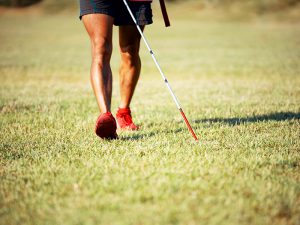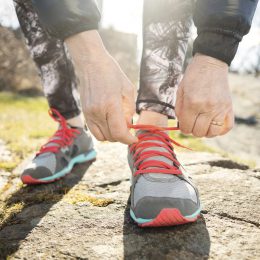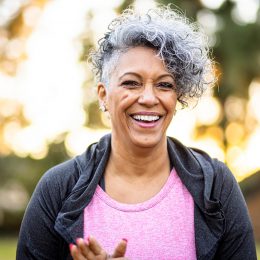Poor Eyesight? 14 Ways to Stay Active, According to an Eye Doctor
Don’t let low vision get in the way of your health goals. Try these strategies to continue living your best life.
 “It’s the old ‘Just do it,’ right?” says optometrist Mark Wilkinson, O.D., speaking about conversations he has with his patients who are dealing with the aftereffects of cataracts or other age-related eye diseases.
“It’s the old ‘Just do it,’ right?” says optometrist Mark Wilkinson, O.D., speaking about conversations he has with his patients who are dealing with the aftereffects of cataracts or other age-related eye diseases.
Living with low-vision problems that can’t be reversed often means modifying the way you do things. And that means tweaking your daily routines so you can hit all your health goals.
“It’s basically saying to people, hey, you can keep doing this. You can do the same things you did before. You may need to modify it a bit. But there’s no reason that just because you can’t see well you can’t still stay physically, socially, and mentally active,” says Wilkinson, who is director of the University of Iowa vision rehab service.
Nearly one in five adults over age 65 reports trouble with their vision. And often, age-related eye diseases—such as macular degeneration, glaucoma, cataracts, and diabetic retinopathy—are to blame.
Yes, low vision can make it harder to stick with a workout routine or cook a healthy meal. But plenty of tools and strategies can help if you have poor eyesight. Here are 14 to get you started.
1. Schedule a Low-Vision Exam
Step one is to make sure you’re maximizing your remaining vision—by paying a visit to a low-vision specialist. This is no typical eye exam, says Erin Kenny, O.D., a low-vision specialist at Salus University. “It’s very goal-oriented.”
Expect to get a bunch of questions about how your daily activities are affected by vision impairment. The specialist can prescribe low-vision aids and suggest strategies aimed at helping you achieve your unique goals.
“Don’t ever assume an activity is not an option,” says Kenny. “You may just have to do it in a new way.”
Ask your optometrist to help you find a low-vision specialist, or reach out to your state’s vision-rehabilitation agency.
2. Recruit a Workout Partner
Any activity you can do with a family member or friend—going on a walk together or riding a tandem bike—is always safer, says Kenny.
On walks, use the sighted guide technique. That’s where you grasp your partner’s elbow with your thumb on the outside and walk a half step behind, explains Wilkinson. You get a lot of tactile feedback this way—the left or right shift when your partner heads in one direction or another, or the slight rise when stepping onto a curb.
Your partner can also give you physical cues, like moving her arm behind her back so you assume single-file in a narrow or crowded space. Also, encourage your partner to give plenty of verbal feedback—not just that you’re approaching steps, but also whether they go up or down and how many there are.
Once you’ve repeated the same route a few times and feel comfortable, you can try it on your own, Kenny suggests.
3. Use a White Cane
This familiar low-vision mobility device can help you detect obstacles while you’re walking. To learn proper technique, you should work with an orientation and mobility specialist.
But once you’ve gotten the hang of it, you can also use a white cane as a way to signal to others that you have low vision.
“Pull it out in a crowd or unfamiliar setting,” suggests Wilkinson. “Just have it out in front of you. You don’t have to tap it back and forth.”
By identifying yourself as someone with low vision, you cue others to pay attention and avoid blocking your path.
You can order a cane online for about $25 (try Ambutech).
4. Seize the Sunny Day
Good lighting can be a game changer for those with low vision, says Kenny. Try to do your outdoor workouts on sunny days, she suggests. Avoid dark paths or trails with a lot of tree cover. And be sure to wear the right sunglasses.
“A lot of people just grab the darkest pair, and that’s not always the answer,” Kenny says. You may need lenses that let in a bit more light. “When you have low vision, it’s this constant balance of having enough light to enhance contrast sensitivity, but also not so much light that you get glare.”
Your low-vision specialist can do a sunglasses evaluation and help you find the perfect pair for you. Many patients find that orange-, plum-, or green-colored lenses help.
5. Hit the Track
Check your local high schools, colleges, and fitness centers to see if they have a running track you can use for your fitness walks and jogs. Because a track is flat and predictable, you’re less likely to encounter obstacles, Kenny notes. Plus, running lanes are often marked with high-contrast lines, making them easy to follow.
6. Bring Some Brightness to the Gym
Most people with low vision struggle with contrast, so spotting a black dumbbell or kettlebell on a dark floor can be tough. Instead, choose colorful weights, or tie a brightly colored exercise band around the weight you’re using, Kenny suggests. If you have to put it down, you’ll be able to find it.
If you golf, you can use a similar strategy on the course. Use a yellow or orange ball so it stands out better against the blue sky.
7. Turn Your Phone into a Magnifier
Can’t make out the options on the treadmill’s touch pad, or having a hard time reading price labels at the grocery store? Use your smartphone as a magnifier, says Kenny. Simply open the camera, and spread your fingers on the screen to zoom in.
8. Take a Dip
Swimming or walking laps in a pool that has both ropes and lane lines (those painted lines on the bottom of the pool) can help you stay oriented.
If you’re swimming, be sure to count how many strokes it takes you to cover the length of the pool. That way you know when you’re approaching the end of your lane and can slow down. Investing in prescription goggles also helps you maximize your vision, says Kenny.
9. Call a Chauffeur
Staying active can feel especially hard when you can no longer drive due to low vision, Wilkinson says. Ride-hailing services like Uber and Lyft can be a game changer. But only a quarter of adults over 50 actually use these apps, the Pew Research Center reports.
“People feel they can’t get out as much if they’re not able to drive,” says Dr. Wilkinson. “But in fact, they can in most locations.”
Consider GoGoGrandparent (1-855-464-6872), a ride concierge service that lets you access Uber or Lyft from a landline or cell phone. The service also monitors your trip to make sure you get safely where you need to go.
10. Ask Your Friends to Say Hi
Social isolation is a major risk factor of disease, especially in older adults. Yet, low vision can make social engagement harder.
“Not being able to recognize faces and nonverbal cues can be frustrating,” Wilkinson says. “I’ve had some patients who say, ‘They think I’m stuck up at the retirement center because I don’t recognize anyone.’”
Many people assume that if you’re not bumping into things, you can see just fine, Wilkinson notes. Identify yourself as someone with low vision by wearing a button that says something like “I don’t see detail. Say hello!” Wilkinson suggests. (Find options at Zazzle.com)
Subscribe to our newsletter
It's quick and easy. You could be one of the 13 million people who are eligible.
Already a member? Click to discover our 15,000+ participating locations.
Follow Us
Also talk to your low-vision specialist about getting a telescope that you can hang on a lanyard around your neck and use to spot faces or signs as needed, says Kenny. And don’t hesitate to tell people about your low vision.
“Once you try interacting, you’ll find you can still do it,” Wilkinson says, “and life can be more joyful than just sitting at home.”
11. Get a Virtual Sous Chef
Home-cooking tends to be healthier than takeout or prepared food—but low contrast sensitivity can make reading your favorite old, food-stained recipes hard.
Try this trick that Wilkinson recommends to his patients: Type your favorite recipes onto a note in your smartphone or tablet, or snap photos of them. That way you can magnify the recipes to make them easier to see. Or if your device has a virtual assistant (like Siri), simply ask to have the recipe read out loud.
12. Make Your Kitchen Comfortable for You
A low-vision specialist can suggest minor modifications and offer strategies to make your kitchen more inviting, says Wilkinson.
A few to try:
- Add task lighting over key countertops.
- Use cutting boards in colors that contrast with your food.
- Apply tactile markers like “bump dots” to help identify key buttons and dials on your oven and microwave.
- Buy a talking thermometer.
13. Do Some E-Reading
Research suggests a link between visual impairment and cognitive decline in older adults, says Kenny. You may be able to mitigate this risk by finding accessible ways to do brain-boosting activities like reading.
“There’s definitely a correlation between cognitive decline and not actively reading because of low vision,” says Kenny.
Going digital can help: With a tablet or e-reader, you can make the text bigger and adjust the contrast. Try enabling dark mode to make the type white against a black background. You’ll reduce glare and increase contrast, easing eye strain and making text easier to see.
14. Seek Help If You Need It
While a low-vision specialist can give you options, you may also need help accepting that daily activities must be done in a different way, Wilkinson says.
“When people start losing their vision, they have to move past denial to acceptance,” he says. “So sometimes people need counseling.”
Cognitive behavioral therapy may be an option for you. This type of talk therapy focuses on helping patients learn how to better manage stressful situations.
Wilkinson has even recommended patients seek the help of a grief counselor to help them learn to let go of that part of themselves.
Whatever method feels right to you, he stresses that with a positive mindset—plus the right strategies—there’s no reason you can’t stay healthy and active.
Take Your Favorite SilverSneakers Classes Online!
SilverSneakers members can access live fitness classes and wellness workshops through SilverSneakers LIVE. See the latest schedule and RSVP for classes here.
Not a member? If you have a Medicare Plan, it may include SilverSneakers—at no additional cost. Check your eligibility instantly here.





